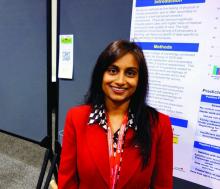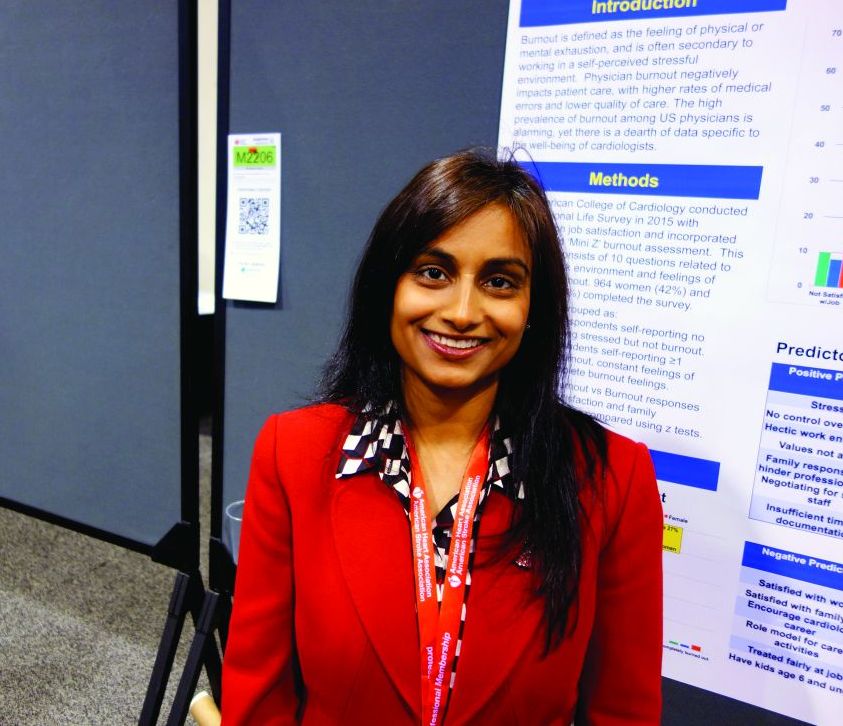User login
ANAHEIM, CALIF. – A disturbingly high 27% of U.S. cardiologists reported currently feeling burnout in the American College of Cardiology’s third Professional Life Survey, Laxmi S. Mehta, MD, said at the American Heart Association scientific sessions.
A gender gap existed: The prevalence of burnout was 29% greater among female cardiologists than their male counterparts, by a margin of 31%-24%.
“These are the doctors who are taking care of people’s hearts, and we know that when you’re burned out, there are higher rates of medical errors and the quality of care is poorer. So this is problematic,” she said in an interview.
Burnout had a negative effect on career satisfaction: While 94% of cardiologists in the nonburnout group professed they were satisfied with their career, that was the case for only 74% of cardiologists who felt burnout. Just 56% percent of the burnout group said they would recommend cardiology as a career, compared with 80% of the practitioners who felt no burnout.
The 2015 ACC survey was completed by 2,313 U.S. cardiologists, 964 of whom were women. The first round of results, which focused on career satisfaction and racial and gender discrimination in the workplace, have been published (J Am Coll Cardiol. 2017 Jan 31;69[4]:452-62). The survey included the validated 10-question Mini Z burnout assessment, the results of which were the focus of the new analysis.
The 27% of cardiologists in the burnout group fell into three subcategories, the largest of which comprised those who reported feeling at least one burnout symptom of physical or mental exhaustion. Those who said their burnout symptoms don’t go away and that they think about their work frustrations frequently made up a smaller group. Just a few percent of survey participants fell into the completely burned out category.
Only 51% of the burnout group were satisfied with their financial compensation, compared with 68% of the nonburnout group. Sixty-one percent of the burnout group felt they were treated fairly at their job, as did 86% of the cardiologists who felt burnout. Half of the cardiologists with burnout reported experiencing past discrimination, compared with 37% of the nonburnout group. And 40% of the burnout group felt their family responsibilities hindered career advancement, a sentiment expressed by 22% of the nonburnout group.
EMR “pajama time” cited as a major burden
Two-thirds of cardiologists with constant burnout symptoms or complete burnout cited excessive time spent completing their electronic medical records as a significant contributing factor.
“The electronic medical record ends up taking over our personal time,” according to Dr. Mehta. “We call it ‘pajama time’ because many of us are doing the charts or responding to patients at midnight, on vacation, at meetings like this. There is no separation, and that’s a problem.”
What can be done to reduce burnout
The 2015 Professional Life Survey was the third one in 20 years. Compared with the earlier two, the most recent survey painted a picture of an aging workforce that is less likely to be in private practice. The survey – the first one to assess burnout within the specialty – was carried out by the ACC Women in Cardiology Leadership Council. Armed with the survey results, the ACC leadership is now in the process of redefining the organization’s mission statement to incorporate a new emphasis on providing for physician health and well-being in addition to the more traditional goals of improving the quality and reducing the cost of care.
“Many cardiologists are working a lot harder than they used to, with less personal time. We need to work on mechanisms to reduce burnout by reducing the burdens put on them. The survey data help because they show the cardiology profession, and hopefully hospital administrators, the importance of making a better work environment. That’s the hope,” Dr. Mehta said.
She reported having no financial conflicts of interest regarding the survey.
ANAHEIM, CALIF. – A disturbingly high 27% of U.S. cardiologists reported currently feeling burnout in the American College of Cardiology’s third Professional Life Survey, Laxmi S. Mehta, MD, said at the American Heart Association scientific sessions.
A gender gap existed: The prevalence of burnout was 29% greater among female cardiologists than their male counterparts, by a margin of 31%-24%.
“These are the doctors who are taking care of people’s hearts, and we know that when you’re burned out, there are higher rates of medical errors and the quality of care is poorer. So this is problematic,” she said in an interview.
Burnout had a negative effect on career satisfaction: While 94% of cardiologists in the nonburnout group professed they were satisfied with their career, that was the case for only 74% of cardiologists who felt burnout. Just 56% percent of the burnout group said they would recommend cardiology as a career, compared with 80% of the practitioners who felt no burnout.
The 2015 ACC survey was completed by 2,313 U.S. cardiologists, 964 of whom were women. The first round of results, which focused on career satisfaction and racial and gender discrimination in the workplace, have been published (J Am Coll Cardiol. 2017 Jan 31;69[4]:452-62). The survey included the validated 10-question Mini Z burnout assessment, the results of which were the focus of the new analysis.
The 27% of cardiologists in the burnout group fell into three subcategories, the largest of which comprised those who reported feeling at least one burnout symptom of physical or mental exhaustion. Those who said their burnout symptoms don’t go away and that they think about their work frustrations frequently made up a smaller group. Just a few percent of survey participants fell into the completely burned out category.
Only 51% of the burnout group were satisfied with their financial compensation, compared with 68% of the nonburnout group. Sixty-one percent of the burnout group felt they were treated fairly at their job, as did 86% of the cardiologists who felt burnout. Half of the cardiologists with burnout reported experiencing past discrimination, compared with 37% of the nonburnout group. And 40% of the burnout group felt their family responsibilities hindered career advancement, a sentiment expressed by 22% of the nonburnout group.
EMR “pajama time” cited as a major burden
Two-thirds of cardiologists with constant burnout symptoms or complete burnout cited excessive time spent completing their electronic medical records as a significant contributing factor.
“The electronic medical record ends up taking over our personal time,” according to Dr. Mehta. “We call it ‘pajama time’ because many of us are doing the charts or responding to patients at midnight, on vacation, at meetings like this. There is no separation, and that’s a problem.”
What can be done to reduce burnout
The 2015 Professional Life Survey was the third one in 20 years. Compared with the earlier two, the most recent survey painted a picture of an aging workforce that is less likely to be in private practice. The survey – the first one to assess burnout within the specialty – was carried out by the ACC Women in Cardiology Leadership Council. Armed with the survey results, the ACC leadership is now in the process of redefining the organization’s mission statement to incorporate a new emphasis on providing for physician health and well-being in addition to the more traditional goals of improving the quality and reducing the cost of care.
“Many cardiologists are working a lot harder than they used to, with less personal time. We need to work on mechanisms to reduce burnout by reducing the burdens put on them. The survey data help because they show the cardiology profession, and hopefully hospital administrators, the importance of making a better work environment. That’s the hope,” Dr. Mehta said.
She reported having no financial conflicts of interest regarding the survey.
ANAHEIM, CALIF. – A disturbingly high 27% of U.S. cardiologists reported currently feeling burnout in the American College of Cardiology’s third Professional Life Survey, Laxmi S. Mehta, MD, said at the American Heart Association scientific sessions.
A gender gap existed: The prevalence of burnout was 29% greater among female cardiologists than their male counterparts, by a margin of 31%-24%.
“These are the doctors who are taking care of people’s hearts, and we know that when you’re burned out, there are higher rates of medical errors and the quality of care is poorer. So this is problematic,” she said in an interview.
Burnout had a negative effect on career satisfaction: While 94% of cardiologists in the nonburnout group professed they were satisfied with their career, that was the case for only 74% of cardiologists who felt burnout. Just 56% percent of the burnout group said they would recommend cardiology as a career, compared with 80% of the practitioners who felt no burnout.
The 2015 ACC survey was completed by 2,313 U.S. cardiologists, 964 of whom were women. The first round of results, which focused on career satisfaction and racial and gender discrimination in the workplace, have been published (J Am Coll Cardiol. 2017 Jan 31;69[4]:452-62). The survey included the validated 10-question Mini Z burnout assessment, the results of which were the focus of the new analysis.
The 27% of cardiologists in the burnout group fell into three subcategories, the largest of which comprised those who reported feeling at least one burnout symptom of physical or mental exhaustion. Those who said their burnout symptoms don’t go away and that they think about their work frustrations frequently made up a smaller group. Just a few percent of survey participants fell into the completely burned out category.
Only 51% of the burnout group were satisfied with their financial compensation, compared with 68% of the nonburnout group. Sixty-one percent of the burnout group felt they were treated fairly at their job, as did 86% of the cardiologists who felt burnout. Half of the cardiologists with burnout reported experiencing past discrimination, compared with 37% of the nonburnout group. And 40% of the burnout group felt their family responsibilities hindered career advancement, a sentiment expressed by 22% of the nonburnout group.
EMR “pajama time” cited as a major burden
Two-thirds of cardiologists with constant burnout symptoms or complete burnout cited excessive time spent completing their electronic medical records as a significant contributing factor.
“The electronic medical record ends up taking over our personal time,” according to Dr. Mehta. “We call it ‘pajama time’ because many of us are doing the charts or responding to patients at midnight, on vacation, at meetings like this. There is no separation, and that’s a problem.”
What can be done to reduce burnout
The 2015 Professional Life Survey was the third one in 20 years. Compared with the earlier two, the most recent survey painted a picture of an aging workforce that is less likely to be in private practice. The survey – the first one to assess burnout within the specialty – was carried out by the ACC Women in Cardiology Leadership Council. Armed with the survey results, the ACC leadership is now in the process of redefining the organization’s mission statement to incorporate a new emphasis on providing for physician health and well-being in addition to the more traditional goals of improving the quality and reducing the cost of care.
“Many cardiologists are working a lot harder than they used to, with less personal time. We need to work on mechanisms to reduce burnout by reducing the burdens put on them. The survey data help because they show the cardiology profession, and hopefully hospital administrators, the importance of making a better work environment. That’s the hope,” Dr. Mehta said.
She reported having no financial conflicts of interest regarding the survey.
AT THE AHA SCIENTIFIC SESSIONS
Key clinical point:
Major finding: There is a noticeable gender gap in U.S. cardiologist burnout.
Data source: This survey of 2,313 U.S. cardiologists addressed burnout and career satisfaction within the profession.
Disclosures: The presenter reported having no financial conflicts of interest regarding the survey, conducted by the American College of Cardiology.

